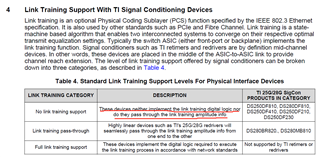
hi, TI's experts:
I don't understant why TI's retimers neither implement the link traning digital logic nor do they pass through the link training amplitude info.
what is link traning digital logic? then what's link training amplitude info?
would you help give an example or some learning data?
I use the Aurota-8B/10B serdes, can I use DS110DF410? so where is the retimer placed, TX or RX?

does the 10Gbase-KR use link traning?

